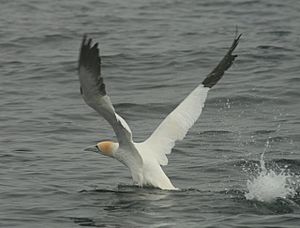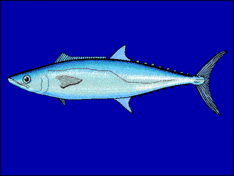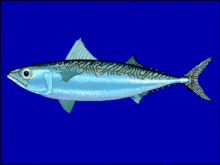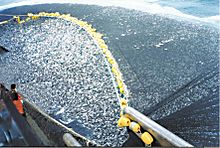Mackerel facts for kids
Mackerel are a group of fish that are very common in the ocean. Most of them belong to the Scombridae family, which also includes larger fish like tuna.
These fish live in the open ocean, both in warm (tropical) and cooler (temperate) waters. You can find them swimming near the coast or further out in the deep sea.
Mackerel usually have cool vertical stripes on their backs and strong, forked tails. They are amazing swimmers, but they are also a favorite meal for bigger ocean animals like cod, sharks, and dolphins.
Mackerel are known as "oily fish" because they are full of healthy fats called omega-3. Their meat can go bad quickly, especially in warm places. So, it's best to eat them soon after they are caught, or keep them cold, or preserve them in salt.
Contents
What Makes Mackerel Special?

Most mackerel are part of the Scombridae family, just like tuna and bonito. Mackerel are usually smaller and thinner than tuna, but they share many similar features.
Their scales are super tiny, or sometimes they don't have any at all! Mackerel love to eat and are very fast and agile swimmers. They can even pull their fins into special grooves on their bodies to swim even faster and smoother through the water.
The Atlantic mackerel (Scomber scombrus) is a great example of a mackerel. These fish are a shiny blue-green on top with a silver belly. They have about 20 to 30 wavy black stripes across their upper body.
You might think these stripes help them hide, but mackerel live in the open ocean where there's nothing to hide behind. Instead, these stripes help them stay together in a group! Fish have a special way of seeing moving stripes. The stripes on other mackerel act like "schooling marks," helping them know where their friends are and how fast they are swimming. This helps the whole group move together efficiently.

Some of the stripes on mackerel even have tiny shiny parts. These parts reflect light differently as the fish moves, giving other mackerel even more clues about how their friends are swimming. This helps them react quickly when they are swimming or looking for food together.
Mackerel come in different sizes, from small fish that are eaten by other animals to larger ones that people like to catch for sport. Small mackerel usually live near the coast. The King mackerel is an example of a larger mackerel.
Most fish are cold-blooded, meaning their body temperature changes with the water around them. But some fish, like the butterfly mackerel, can keep their bodies warmer than the surrounding water.
Mackerel are very strong swimmers. An Atlantic mackerel can swim steadily at about 1 meter per second and can burst to speeds of over 5 meters per second!
Where Mackerel Live and Travel
Most mackerel species live in specific areas of the ocean.
- The Atlantic Spanish mackerel lives off the east coast of North America, from Cape Cod down to the Yucatán Peninsula. In summer, they travel north from Florida to lay their eggs near the New England coast. Then they return to Florida for winter. Another group travels along the coast from Mexico to lay eggs in the Gulf of Mexico off Texas, returning to Mexico for winter.
- The Atlantic mackerel is a coastal fish found only in the North Atlantic Ocean. The groups on the west side of the Atlantic are mostly separate from those on the east side. The east Atlantic mackerel are divided into three main groups, each with their own travel patterns.
- The chub mackerel is not found in the Atlantic Ocean, but it lives all over the Pacific Ocean. Its travel patterns are similar to the Atlantic mackerel. In summer, they travel north to find food, and in winter, they travel south to lay their eggs in shallower waters.
- The Chilean jack mackerel is found in the South Pacific, from West Australia to the coasts of Chile and Peru. This species is caught more than any other mackerel-like fish. It lives near the coast where deep, cold water rises to the surface, but it also travels across the open ocean. Its numbers can change a lot, especially during El Niño events.
Some mackerel species also travel up and down in the water. Adult snake mackerels stay in deeper water during the day and come up to the surface at night to eat. Young snake mackerel do the opposite, staying near the surface during the day and moving deeper at night. These fish eat squid, small crustaceans, and other fish. In turn, they are eaten by tuna and marlin.
Life Cycle of Mackerel

Mackerel lay a lot of eggs! They release their eggs into the water near the surface because the eggs float. A single female mackerel can lay between 300,000 and 1,500,000 eggs.
Both the eggs and the tiny baby mackerel (called larvae) float freely in the open sea. The larvae and young mackerel eat tiny ocean creatures called zooplankton. As they grow into adults, they develop sharp teeth and hunt small crustaceans like copepods, as well as small fish, shrimp, and squid.
Bigger ocean animals hunt mackerel, including tuna, billfish, sea lions, sharks, and pelicans. Off the coast of Madagascar, spinner sharks follow groups of migrating mackerel. Even large Bryde's whales eat mackerel when they can find them, using different ways to catch them, like skimming the surface or lunging through schools of fish.
Mackerel Fishing
The chub mackerel (Scomber japonicus) is the most caught type of mackerel in the Scombridae family. They make up about half of all mackerel caught. Chub mackerel travel long distances across oceans and the Mediterranean Sea. They are often caught at night using large nets called surround nets, by attracting them with bright lamps.
The rest of the mackerel catch is split between the Atlantic mackerel and all other types of scombroid mackerel. So, just two species, the chub mackerel and the Atlantic mackerel, make up about 75% of all scombroid mackerel caught.
The Chilean jack mackerel is the most commonly caught non-scombroid mackerel. Unfortunately, too many of these fish have been caught, and their numbers might be in danger of dropping too low.
Smaller mackerel often swim in large groups, similar to herring. They are caught using methods like purse seining. Big fishing boats use small planes to find these groups of fish. Then, they use special sonar to track the shape of the fish group. Fast smaller boats then surround the entire group with huge nets.
Some fishing boats called trollers can also catch mackerel when they swim near the surface. These boats have long poles that they lift and drop, pulling in their fishing lines with electric or hydraulic machines. Fishermen also use special devices that attract fish, called Fish aggregating devices, to catch mackerel.
Images for kids
-
Still life with mackerel, lemon and tomato, by Vincent van Gogh, 1886
See also
 In Spanish: Verdel para niños
In Spanish: Verdel para niños






